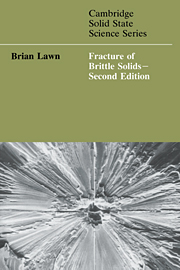Book contents
- Frontmatter
- Contents
- Preface
- Glossary of symbols and abbreviations
- 1 The Griffith concept
- 2 Continuum aspects of crack propagation I: linear elastic crack-tip field
- 3 Continuum aspects of crack propagation II: nonlinear crack-tip field
- 4 Unstable crack propagation: dynamic fracture
- 5 Chemical processes in crack propagation: kinetic fracture
- 6 Atomic aspects of fracture
- 7 Microstructure and toughness
- 8 Indentation fracture
- 9 Crack initiation: flaws
- 10 Strength and reliability
- References and reading list
- Index
7 - Microstructure and toughness
Published online by Cambridge University Press: 14 January 2010
- Frontmatter
- Contents
- Preface
- Glossary of symbols and abbreviations
- 1 The Griffith concept
- 2 Continuum aspects of crack propagation I: linear elastic crack-tip field
- 3 Continuum aspects of crack propagation II: nonlinear crack-tip field
- 4 Unstable crack propagation: dynamic fracture
- 5 Chemical processes in crack propagation: kinetic fracture
- 6 Atomic aspects of fracture
- 7 Microstructure and toughness
- 8 Indentation fracture
- 9 Crack initiation: flaws
- 10 Strength and reliability
- References and reading list
- Index
Summary
We have thus far dealt with the resistance to crack propagation at opposite extremes of material representation, continuum solid and atomic lattice. It is now appropriate to investigate the problem at an intermediate level, that of the microstructure. By ‘microstructure’ we mean the compositional configuration of discrete structural ‘defects’: voids, inclusions, secondphase particles (volume defects); secondary crack surfaces, grain boundaries, stacking faults, twin or phase boundaries (surface defects); dislocations (line defects). It is principally at this intermediate level that significant improvements in the mechanical properties of traditional brittle polycrystalline ceramics (cf. table 3.1) may be realised. By tailoring the microstructure it is possible to introduce an interactive defect structure that acts as an effective restraint on crack propagation and thus enhances the material toughness.
In this chapter we examine some of these ‘toughening’ interactions. We identify two classes of restraint. The first involves purely geometrical processes, deflections along or across weak interfaces, etc. The responsible microstructural elements may be regarded as ‘transitory obstacles’, in the sense that their impeding influence lasts only for the duration of crackfront intersection. Because of their ephemeral nature such interactions are relatively ineffective as sources of toughening, accounting at very most for increases of a factor of four in crack-resistance energy R or, equivalently, a factor of two in toughness T.
The second class of restraint comprises shielding processes. The critical interactions occur away from the tip, within a ‘frontal zone’ ahead or at a ‘bridged interface’ behind.
- Type
- Chapter
- Information
- Fracture of Brittle Solids , pp. 194 - 248Publisher: Cambridge University PressPrint publication year: 1993
- 4
- Cited by



